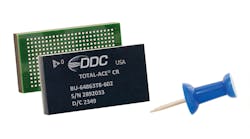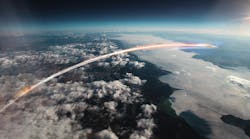By John McHale
CLARKSTON, Wash. — Officials at Isothermal Systems Research have selected Signal Technology Corp.'s Keltec division in Fort Walton Beach, Fla., to develop reliable power supplies using Isothermal's fluid spray cooling technology for the U.S. Navy's EA-6B Prowler carrier-based electronic warfare jet.
The EA-6B application represents the first mainstream avionics platform for Isothermal's technology with actual flight tests scheduled in 18 months, says David Tilton, Isothermal's product specialist.
Isothermal's work on the EA-6B is part of the largest contract in the company's history — a $35 million contract to supply their spray-cooled electronics chassis to all branches of the U.S. military.
The first leg of the transaction will supply Isothermal's chassis to the U.S. Marine Corps for the Advanced Amphibious Assault Vehicle (AAAV). Other candidates include the U.S. Navy's EA-6B, the U.S. Air Force's F-16 jet fighter, and the U.S. Army's M1A1 main battle tank.
The spray-cooled power supplies will replace old conduction-cooled devices in the Prowler's tail cap, Tilton says.
Installing a spray-cooled system on an aircraft generates the same challenges that conduction or convection cooled systems would face such as lack of atmosphere and rough carrier landings, Tilton says. However one the biggest issues for Isothermal engineers is maintaining fluid flow during a change in orientation, he says.
For example an aircraft that pulls Gs by rolling, pitching, or yawing could cause unwanted shifting of the cooling fluid, Tilton explains. Isothermal engineers have designed independent valves that can sense whether fluid is present or not and open and close the valves accordingly, Tilton adds.
Demand for "high reliability, low-voltage power supplies will dramatically expand," as the U.S. military increasingly uses commercial technology to upgrade aging power supplies and distribution architectures, says John Cotumaccio, president of Keltec.
Isothermal officials claim their spray-cooling approach is enabling electronic systems designers to use commercial-off-the-shelf, or COTS, technology.
Isothermal experts use spray cooling to remove heat from electronic systems with a liquid chemical spray, rather than with moving air or metal heat sinks. Spray cooling removes heat from single-board computers more than 500 times more efficiently than air cooling, Isothermal officials claim. Conventional air-cooled systems are limited to a power density of about 1-watt per cubic inch, while spray cooling can cool systems running at more than 500 watts per cubic inch, company officials say.
For more information on Isothermal's spray-cooled electronic chassis contact Donald Tilton by phone at 509-758-2613, by fax at 509-758-1280, by mail at Isothermal Systems Research, 511 Third Street, Clarkston, Wash. 99403, or on the World Wide Web at http://www.spraycool.com.


